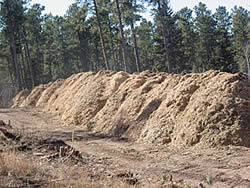
National Fire Plan Success Story
Stewardship Project Provides Ethanol for the Country
Deer Mountain Stewardship, South Dakota
National Fire Plan - Community Assistance / Woody Biomass Utilization
The Deer Mountain Stewardship is located five miles south of Lead, South Dakota in the Wildand Urban Interface. The project size was 85 acres and included harvesting 1,100 tons of Ponderosa Pine sawlogs and about 450 tons of spruce sawlogs
The purpose was to reduce the wildland fire intensity near the numerous subdivisions built and being built around the BLM administered lands. It was also to decrease the density of the smaller new growth trees to help promote the growth of the older age trees. A fire containment zone was created along the major road. A fire containment zone is a zone along a road anywhere from 100 feet to 300 feet wide that is thinned out even more than a regular thinning project to help slow a fire and is accessible for fire personnel and vehicles. The fire containment zone is more of a park-like stand.
This project was unique for the South Dakota Field Office and is the first stewardship where the biomass left over from logging will be turned into ethanol. Ethanol is created when the polymers in the wood are broken down by an enzyme and turned into glucose, which can be fermented and refined

The horizontal grinder ground the biomass leaving piles to be loaded onto trucks and hauled to Upton, Wyoming.
The project is very beneficial for both the public and the BLM. In previous contracts, the biomass created is either burned in piles or under ground and then spread on the ground. The biomass created from this stewardship will go to the ethanol plant for fuel. It will save money that would have been used to burn the piles. This process was started in the Black Hills this past year.
The commercial sized trees marked were cut by a Timbco and whole tree skidded to a pre-determined landing. The trees were then measured and cut by a boom de-limber. The biomass remaining was piled into 150 foot by 75 foot piles. Then, the contractor used a Timbco with a grapple hook on the end to feed a horizontal grinder controlled by the Timbco operator via remote to grind the biomass into wood chips. The wood chips are then loaded into trucks and hauled to Upton, Wyoming where a new ethanol plant opened in March of 2007. The ethanol plant in Upton is the first of its kind in the nation. The plant can produce about 1.5 million gallons of Ethanol.